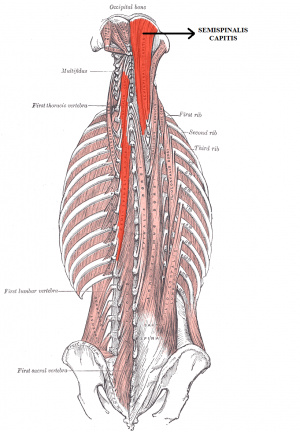Semispinalis Capitis: Difference between revisions
Scott Buxton (talk | contribs) No edit summary |
Venus Pagare (talk | contribs) No edit summary |
||
| Line 6: | Line 6: | ||
== Description == | == Description == | ||
The posterior muscles of the neck are divided into four layers. The semispinalis capitis and cervicis muscles lie within the third layer<ref name="Rez">Rezasoltani. A. Kallinen. M . Mälkiä. M. Vihko. V. Neck semispinalis capitis muscle size in sitting and prone positions measured by real-timefckLRultrasonography. Clinical Rehabilitation 1998; 12: 36–44.</ref>. The semispinalis capitis is a long slender muscle which provided a long moment arm to provide efficient extension. | The posterior muscles of the neck are divided into four layers. The semispinalis capitis and cervicis muscles lie within the third layer<ref name="Rez">Rezasoltani. A. Kallinen. M . Mälkiä. M. Vihko. V. Neck semispinalis capitis muscle size in sitting and prone positions measured by real-timefckLRultrasonography. Clinical Rehabilitation 1998; 12: 36–44.</ref>. The semispinalis capitis is a long slender muscle which provided a long moment arm to provide efficient extension. | ||
[[Image:SEMISPINALIS_CAPITIS.png|center|300x500px]] | |||
== Origin == | == Origin == | ||
| Line 26: | Line 28: | ||
== Action == | == Action == | ||
Extension of the neck. When one sided, it produces extension and minimal lateral flexion. | Extension of the neck. When one sided, it produces extension and minimal lateral flexion. | ||
== Function == | == Function == | ||
During bilateral contraction this muscle is considered as a prime mover for dynamically maintaining the cervical lordosis<ref name="port">Porterfield JA, DeRosa C. Mechanical neck pain, | During bilateral contraction this muscle is considered as a prime mover for dynamically maintaining the cervical lordosis<ref name="port">Porterfield JA, DeRosa C. Mechanical neck pain,fckLRperspective in functional anatomy. Philadelphia: WB Saunders, 1995.</ref>. It is also considered as one of the main factors in maintaining the balance of the head on the neck<ref name="sinclair">Sinclair D. Functional anatomy, fifth edition.fckLRLondon: B.S. Publication, 1975</ref> | ||
== Recent Related Research (from [http://www.ncbi.nlm.nih.gov/pubmed/ Pubmed]) == | == Recent Related Research (from [http://www.ncbi.nlm.nih.gov/pubmed/ Pubmed]) == | ||
| Line 38: | Line 38: | ||
<rss>http://www.ncbi.nlm.nih.gov/entrez/eutils/erss.cgi?rss_guid=12sSGUzk9qnDVzk4XrPjzhpAyHrWZ58zUo6Ppapd5PdEaFxkYM|charset=UTF-8|short|max=10</rss> | <rss>http://www.ncbi.nlm.nih.gov/entrez/eutils/erss.cgi?rss_guid=12sSGUzk9qnDVzk4XrPjzhpAyHrWZ58zUo6Ppapd5PdEaFxkYM|charset=UTF-8|short|max=10</rss> | ||
</div> | </div> | ||
<br> | |||
== References == | == References == | ||
Revision as of 21:18, 26 January 2014
Original Editor - Scott Buxton
Lead Editors - Venus Pagare, Scott Buxton, WikiSysop, Kim Jackson, Lucinda hampton and Admin
Description[edit | edit source]
The posterior muscles of the neck are divided into four layers. The semispinalis capitis and cervicis muscles lie within the third layer[1]. The semispinalis capitis is a long slender muscle which provided a long moment arm to provide efficient extension.
Origin[edit | edit source]
The muscle originates on the articular processes of the C 5, 6, 7 and 8 as well as the transverse processes of T 1, 2 ,3 ,4 ,5 and 6.
Insertion[edit | edit source]
The semispinalis capitis attaches onto the occiput inbetween the superior and inferior nuchal line.
Nerve Supply[edit | edit source]
Greater occipital nerve, which additionally innervates the scalp[2].
Blood Supply[edit | edit source]
Deep cervical artery.
Action[edit | edit source]
Extension of the neck. When one sided, it produces extension and minimal lateral flexion.
Function[edit | edit source]
During bilateral contraction this muscle is considered as a prime mover for dynamically maintaining the cervical lordosis[3]. It is also considered as one of the main factors in maintaining the balance of the head on the neck[4]
Recent Related Research (from Pubmed)[edit | edit source]
Failed to load RSS feed from http://www.ncbi.nlm.nih.gov/entrez/eutils/erss.cgi?rss_guid=12sSGUzk9qnDVzk4XrPjzhpAyHrWZ58zUo6Ppapd5PdEaFxkYM|charset=UTF-8|short|max=10: Error parsing XML for RSS
References[edit | edit source]
- ↑ Rezasoltani. A. Kallinen. M . Mälkiä. M. Vihko. V. Neck semispinalis capitis muscle size in sitting and prone positions measured by real-timefckLRultrasonography. Clinical Rehabilitation 1998; 12: 36–44.
- ↑ Natsis K, Baraliakos X, Appell HJ, Tsikaras P, Gigis I, Koebke J. The course of the greater occipital nerve in the suboccipital region: a proposal for setting landmarks for local anesthesia in patients with occipital neuralgia. Clinical Anatomy. 2006 May;19(4):332-6.
- ↑ Porterfield JA, DeRosa C. Mechanical neck pain,fckLRperspective in functional anatomy. Philadelphia: WB Saunders, 1995.
- ↑ Sinclair D. Functional anatomy, fifth edition.fckLRLondon: B.S. Publication, 1975







